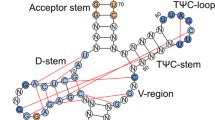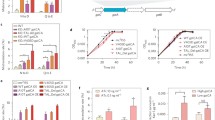Summary
We have compared the suppression of nonsense mutations by aminoglycoside antibiotics inEscherichia coli and in human 293 cells. Six nonsense alleles of the chloramphenicol acetyl transferase (cat) gene, in the vector pRSVcat, were suppressed by growth in G418 and paromomycin. Readthrough at UAG, UAA and UGA codons was monitored with enzyme assays for chloramphenicol acetyl transferase (CAT), in stably transformed bacteria and during transient expression from the same plasmid in human 293 tissue culture cells. We have found significant differences in the degree of suppression amongst three UAG codons and two UAA codons in different mRNA contexts. However, the pattern of these effects are not the same in the two organisms. Our data suggest that context effects of nonsense suppression may operate under different rules inE. coli and human cells.
Similar content being viewed by others
References
Bossi L (1983) Context effects. Translation of UAG codon by suppressor tRNA is affected by the sequence following UAG in the message. J Mol Biol 164:73–87
Bouadloun F, Donner D, Kurland CG (1983) Codon specific missense errors in vivo. EMBO J 2:1351–1356
Bradford MA (1976) A rapid and sensitive method for the quantitation of microgram quantitation of protein utilizing the principle of protein dye-binding. Anal Biochem 72:248–254
Buchanan JH, Stevens A, Sidhu J (1987) Aminoglycoside antibiotic treatment of human fibroblasts: intracellular accumulation, molecular changes and the loss of ribosomal accuracy. Eur J Cell Biol 43:141–147
Burke JF, Mogg AE (1985a) Construction of a vector, pRSVcat amb38, for the rapid and sensitive assay of amber suppression in human and other mammalian cells. Nucleic Acids Res 13:1317–1326
Burke JF, Mogg AE (1985b) Suppression of a nonsense mutation in mammalian cellsin vivo by the aminoglycoside antibiotics G-418 and paromomycin. Nucleic Acids Res 13:6265–6272
Capone JP, Sharp PA, RajBhandary UL (1985) Amber ochre and opal suppressor tRNA genes derived from a human serine tRNA gene. EMBO J 4:213–221
Capone JP, Sedivy JM, Sharp PA, RajBhandary UL (1986) Introduction of UAG, UAA and UGA nonsense mutations at a specific site in theEscherichia coli chloramphenicol acetyl transferase gene: use in measurement of amber, ochre and opal suppression in mammalian cells. Mol Cell Biol 6:3059–3067
Capone JP, Sharp PA, RajBhandary UK (1985) Amber ochre and opal suppressor tRNA genes derived from a human serine tRNA gene. EMBO J 4:213–221
Capone JP, Sedivy JM, Sharp PA, RajBhandary UL (1986) Introduction of UAG, UAA and UGA nonsense mutations at a specific site in theEscherichia coli chloramphenicol acetyl transferase gene: use in measurement of amber, ochre and opal suppression in mammalian cells. Mol Cell Biol 6:3059–3067
Davies J (1966) Streptomycin and the genetic code. Cold Spring Harbor Symp Quant Biol 31:665–670
Edelmann P, Martin R, Gallant J (1987) Nonsense suppression context effects inEscherichia coli bacteriophage T4. Mol Gen Genet 207:517–518
Ellis N, Gallant J (1982) An estimate of the global error frequency in translation. Mol Gen Genet 188:169–172
Faxen M, Kirsebom LA, Isaksson LA (1988) Is efficiency of suppressor tRNAs controlled at the level of ribosomal proofreading in vivo? J Bacteriol 170:3756–3760
Fluck MM, Salser W, Epstein RH (1977) The influence of the context upon the suppression of nonsense codons. Mol Gen Genet 151:137–149
Gorini L (1970) Informational suppression. Annu Rev Genet 4:107–134
Gorini L, Kataja E (1964) Phenotypic repair by streptomycin of defective genotypes inE. coli. Proc Natl Acad Sci USA 51:487–493
Graham FL, Van der Eb A (1973) New technique for assay of infectivity of adenovirus 5 DNA. J Virol 52:456–467
Graham FL, Smiley J, Russel WC, Nairn R (1977) Characteristics of a human cell line transformed by DNA from Human Adenovirus type 5. J Gen Virol 36:59–72
Hodgkin J, Kondo K, Waterston RH (1987) Suppression in the nematodeCaenorhabditis elegans. Trends Genet 3:325–329
Ish-Horowicz D, Burke JF (1981) Rapid and efficient cosmid vector cloning. Nucleic Acids Res 9:2987–2989
Johnston RC, Parker J (1985)_Streptomycin induced, third position misreading of the genetic code. J Mol Biol 181:313–315
Kohli J, Grosjean H (1981) Usage of the three termination codons: Compilation and analysis of the known eukaryotic and prokaryotic translation termination sequences. Mol Gen Genet 182:430–439
Kurland CG (1987a) Strategies for efficiency and accuracy in gene expression. 1. The major codon preference; a growth optimization strategy. Trends Biochem Sci 12:126–128
Kurland CG (1987b) Strategies for efficiency and accuracy in gene expression. 2. Growth optimized ribosomes. Trends Biochem Sci 12:169–171
Kurland CG (1987c) Strategies for efficiency and accuracy in gene expression. 3. Drug dependence: growth at the edge. Trends Biochem Sci 12:210–212
Laski FA, Belagaje R, RajBhandary UL, Sharp PA (1982) An amber suppressor tRNA gene derived by site specific mutagenesis: cloning and expression in mammalian cells. Proc Natl Acad Sci USA 79:5813–5817
Loftfield RB, Vanderjagt D (1972) The frequency of errors in protein biosynthesis. Biochem J 128:1353–1356
Maniatis T, Fritsch EF, Sambrook J (1982) Molecular cloning: a laboratory manual. Cold Spring Harbor Laboratory Press, Cold Spring Harbor, New York
Martin R, Hearn M, Jenny P, Gallant J (1988a) Release factor competition is equivalent at strong and weakly suppressed nonsense codons. Mol Gen Genet 213:144–149
Martin R, Weiner M, Gallant J (1988b) Effects of release factor context at UAA codons inEscherichia coli. J Bacteriol 170:4714–4717
Messing J (1983) New M13 vectors for cloning. Methods Enzymol 101:20–78
Miller JH, Albertini AM (1983) Effects of surrounding sequence on the suppression of nonsense codons. J Mol Biol 164:59–71
Palmer E, Wilhelm JM, Sherman F (1979) Phenotypic suppression of nonsense mutants in yeast by aminoglycoside antibiotics. Nature 277:148–150
Parker J, Johnston JC, Borgia TP (1980) Mistranslation in cells infected with the bacteriophage MS2: direct evidence of Lys and Asn substitution. Mol Gen Genet 180:275–281
Ruusala T, Kurland CG (1984) Streptomycin perturbs preferentially ribosomal proof reading. Mol Gen Genet 198:100–104
Salser W (1969) The influence of the reading context of the suppression of nonsense codons. Mol Gen Genet 105:125–130
Sanger F, Nicklen S, Coulson AR (1977) DNA sequencing with chain terminating inhibitors. Proc Natl Acad Sci USA 74:5463–5467
Sedivy JM, Capone JP, RajBhandary UL, Sharp PA (1987) An inducible mammalian amber suppressor: Propagation of a polio virus mutant. Cell 50:379–389
Sherman F (1982) Suppression in the yeastSaccharomyces cerevisiae. In: Strathern JN, Jones EW, Broach JR (eds) Molecular biology of the yeastSaccharomyces — Metabolism and gene expression. Cold Spring Harbor Laboratory Press, Cold Spring Harbor, NY, pp 463–486
Stormo GD, Schneider TD, Gold L (1986) Quantitative analysis of the relationship between nucleotide sequence and functional activity. Nucleic Acids Res 14:6661–6679
Weintraub H, Cheng PF, Conrad K (1986) Expression of transfected DNA depends on DNA topology. Cell 46:115–122
Woese CR (1973) Evolution of the Genetic Code. Naturwissenschaften 60:447–459
Author information
Authors and Affiliations
Additional information
Communicated by K. Illmensee
Rights and permissions
About this article
Cite this article
Martin, R., Mogg, A.E., Heywood, L.A. et al. Aminoglycoside suppression at UAG, UAA and UGA codons inEscherichia coli and human tissue culture cells. Molec. Gen. Genet. 217, 411–418 (1989). https://doi.org/10.1007/BF02464911
Received:
Issue Date:
DOI: https://doi.org/10.1007/BF02464911




